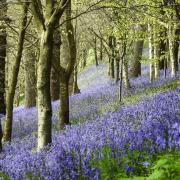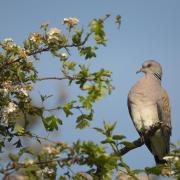Paradise Wildlife Park has evolved to become a leading force in animal conservation. We catch up with human resident Cam Whitnall...
When you visit the outskirts of Broxbourne, a large roar is probably not the usual sound you expect to hear in the Hertfordshire countryside. But for Cameroon Whitnall and his family, owners of Paradise Wildlife Park, the sounds of the jungle are part of everyday life.
The zoo was purchased by Cam’s grandfather Peter Sampson in 1984. Peter ran Sampson Coaches and was looking for land to house the business. The 30-acre site known as Broxbourne Zoo (it was dubbed the worst zoo in Britain) was the perfect place but unfortunately it came with lots of animals and council stipulated they had to remain. Despite never having seen a lion or tiger, Peter purchased the zoo on April 1 and within a few weeks had fallen in love with it and decided to sell the coach business.

‘We had a very different experience as kids that’s for sure,’ laughs Cam. When it came to school everyone knew me as the zoo guy. Show and tell must have been interesting I ask? ‘No one could really compete unfortunately, I always felt bad, people would talk about rabbits and hamsters and I was talking about lions and tigers.’
The 27-year-olds favourite time was going around at night when the zoo was closed and being around the animals from a young age taught him how to care and protect them. ‘As I grew up I started to learn a lot more about conservation,’ he explains. ‘A lot of my friends weren’t that interested but seeing the kids of today and the future generation it's a cool thing to work with animals or in conservation. It’s nice to see the impact that it’s having on animals in general. We are also educating our visitors which is making a big difference.’
The zoo is home to 800 animals, from little squirrel monkeys to an anaconda called Optimus Prime. Paradise also focuses on endangered species and conservation projects around the world. ‘Take our amur Tigers,’ says Cam. ‘They are critically endangered - there’s only around 400 to 500 in the wild.’
The latest editions to the park are two adorable Malayan sun bears - Kyra and Indera, which are classed as vulnerable on the IUCN list. ‘They are absolutely beautiful animals,’ Cam says. ‘I was out in Southeast Asia recently to do work on the frontline with our new conservation partner, Bornean Sun Bear Conservation Centre run by Dr Wong. It’s important to learn about their threats and how we are supporting sun bears on an international level. Dr Wong believes they should be classed as endangered because they are incredibly hard to research. He's only ever seen seven sun bears in the wild and he has been studying them pretty much his entire life.

‘The aim is to have Kyra and Indera on the breeding programme. It will take a bit of time for them to get to know each other of course and there's no guarantee they will have cubs. But it is so important to keep that healthy genetic bloodline in captivity.’
Breeding successes at the park include African penguins, rare Black Hornbill chicks and a red panda, Tashi (meaning hope) born last year. The day after they launched the Zoological Society of Hertfordshire in 2017, a jaguar cub was born – the first time the park had successfully bred jaguars as part of the international breeding programme. There are also plans to add the patter of paws of snow leopards.
The role of zoos is changing. Good zoos now provide not research but support conservation projects and are now the third largest donor to conservation globally.
‘We always say in an ideal world, zoos wouldn’t exist,’ says Cam. ‘I think in today's world there is good and bad in everything and you can say that in zoos as well. We want to promote the conservation work that we do as a charity and the welfare we provide for our animals. We educate over 450,000 visitors year. It’s important for people to learn about these animals and learn about how they can provide a better future for them. At the end of the day conservation starts from home. If we can get people to appreciate nature and get up close and see animals here, then hopefully it will have a ripple effect. We have people that have visited the park and they now work here or have gone off to conservation sites around the world or to other environmental or animal organisations.

‘When planning projects in the future, we always look at what can we put in the habitat which will support the animal’s welfare and behavioural needs to give them the best and most comfortable life possible and you can see that with our jaguars and bears for instance. Our animals are one of us and that's how we treat them; we celebrate their birthdays.’
Through its charity Zoological Society of Hertfordshire, they have supported conservation projects including Drive4Wildlife, which saw a team from Paradise drive around Tanzania, Uganda, Rwanda and Kenya delivering equipment and funds to conservation charities to see the work that they do first hand. ‘Through that trip we actually raised enough funds to donate Uganda's first ever animal ambulance which has rescued over 500 animals which are then released back into the wild,’

In 2000 they launched The Big Cat Sanctuary in Kent which is dedicated to the welfare and conservation of big and small cats. It is currently home to an amur leopard which is the most endangered big cat in the world with only 100 remaining in the wild. And closer to home they have launched the big bird box build, creating swift boxes from the offcuts of wood used in building the latest new habitats Jaguar Jungle and Sun Bear Heights.
Does Cam have a favourite animal? ‘Any animal that is in front of me becomes my favourite, it could be a pigeon, red squirrel or a tiger. I fall in love with individual personalities and characters because every animal is different. Right now, it would probably be the sun bears. I absolutely adore them and our jaguars are probably top of my list at the moment.’
Along with his brothers Tyler and Aaron, he is currently filming another series of the successful CBBC series One Zoo Three, which follows what the boys get up to at both Paradise Wildlife Park, The Big Cat Sanctuary and their conservation adventures around the world. They also have a new spin off series OZT Goes Wild in Britain.

‘It’s kind of like a Top Gear meets animals and kids,’ says Cam. ‘We have our own studio with a live audience of kids and drive around in our electric car looking at all the amazing conservation stories taking place around Britain. It’s amazing. So many people don't realise the incredible species that we have here. If you are a kid, have kids or just a big kid, it’s a lot of fun.’
Next year the park celebrates its 40th anniversary and will be renamed Hertfordshire Zoo; part of a long-term masterplan to support even more endangered species. ‘It is going to change the whole of the feel of the entire site, so watch this space,’ says Cam. ‘We want to be a leading zoo. I am massively proud of what we are doing for wildlife, we are making a difference not only here but around the world.’
pwpark.com



























